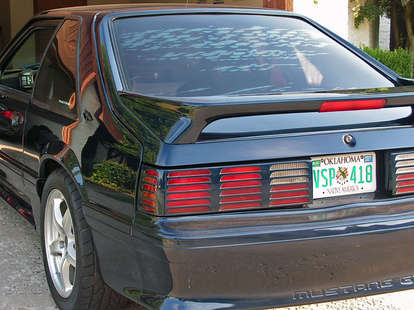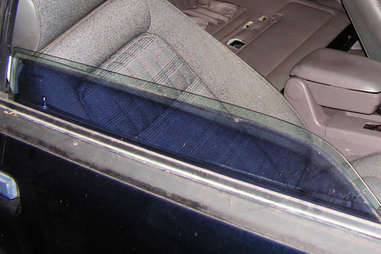How to Spot a Bad Tint Job

Nothing ruins the aesthetic of an otherwise gorgeous car like a shoddy tint job. Worse still is trying to see through that ruinously bad streak of bubbles between the window and the translucent purplish film that once qualified as tint. As you can see above, my old Mustang suffered from this embarrassing affliction.
After years of going without tint, watching temperatures in my car soar past 130 degrees this summer was a solid reminder of how crucial it can be. I had literally forgotten what it was like to drive in the summer and not sweat, so I went to the tinting pros at 3M to have my car done. I had a few chats with them about what separates a quality tint job from a bad one. Whether you're checking out a used car or having yours tinted for the first time, here's what you should know.

Your No. 1 visual clue: good tint has small, clean edges
To tell if a car has a quality tint, see how close the film comes to the window edge, and take note of how consistent and clean the line is. A top-notch installer uses computerized templates that pre-cut the film as much as possible, resulting in a line that's close to the edge of the window pane and doesn't waver. As opposed to my poor old Mustang, above, where there’s a significant gap and it looks all-around shitty.
And purple is the enemy
Only one person could properly get away with purple windows (RIP Prince!), but you'd never know it given the tremendous number of cars on the road with tint that has turned purple with age. It's an obvious sign that the film is of the most basic quality possible, a vinyl sheet with dyes that fade over time.
Look for tiny bubbles that distort your view
Make sure you check out how clear your view is. Obviously huge bubbles are a no-brainer red flag, but even very, very small bubbles cause distortion. A good tint installer will minimize the risk of bubbles, but if you've used a low-quality tint, they can form as early as six months down the road as the adhesive begins to break down prematurely.

Check out the dot matrix
No, I'm not talking about the space-traveling robot with the built-in virgin alarm. The little dots you see at the edge of many car windows are 3D, and the textured surface makes tinting exceedingly difficult. Often you'll see film that sticks to some spots but not others, and the result is a horrendous zig-zagging line. Sometimes, an installer will attempt to fill the blank spaces with glue so it looks filled in, which might work in the short term, but is more likely to fail down the road.
A better, but far more time-intensive (read: $$$) solution is for the installer to take the time to sand the dots down. For a car that's already been tinted, what you want to see is an incredibly consistent line that goes right to the edge of the dot matrix.

Look for gaps and bubbles around the defroster bars
As with the dot matrix, your rear window's defroster is 3D. Any excess gap where the tint is firmly affixed to the window will become an excellent starting point for bubbles to form and expand over time. You want to make sure the tint is pressed as tightly against the defroster as possible.
High-quality tints aren't always a dark shade
Don't automatically assume that a dark tint has the best heat-blocking properties. While the car is in the sun, put one hand directly in the sun and one hand behind the window, so you can feel the difference. Yes, as a general rule, the darker the tint, the greater the heat reduction, but a high-quality ceramic tint like Huper Optik or a spectrally selective tint like 3M's Crystalline line is more efficient, meaning a lighter shade can still be more effective than a dark shade of the cheap stuff.
Some dark metallic tints will interfere with your cell reception. Seriously.
A lot of films are made with metallic elements -- think silver or gold, like an '80s limo -- to help reflect light (and thus heat energy) away from the car. It's actually highly effective and for years it was the (no pun intended) gold standard... but be warned: it does have a tendency to interfere with things like cellphone and radio reception.

Make sure the windshield is done
It's legal to put a very (almost clear) light tint on the windshield -- but not in every state, so know your laws. If it's legal where you live, definitely do it. The windshield is the largest window on your car -- if you tint everything else but leave the windshield bare, it kinda defeats the purpose. This is where those really high-quality tints that don't have to be as dark come into play.
And that it doesn't have any cutouts
A lot of installers will cut out sections of the film on the windshield for things like your inspection or registration stickers, so that you can remove them when the time comes without damaging the film. That's unnecessary, and results in an unsightly line at the edge of the film. A good install will involve placing those stickers on a clear film that essentially converts them to static-cling decals.
Want more of the world's best Cars delivered straight to your inbox? Click here to sign up for our daily email.